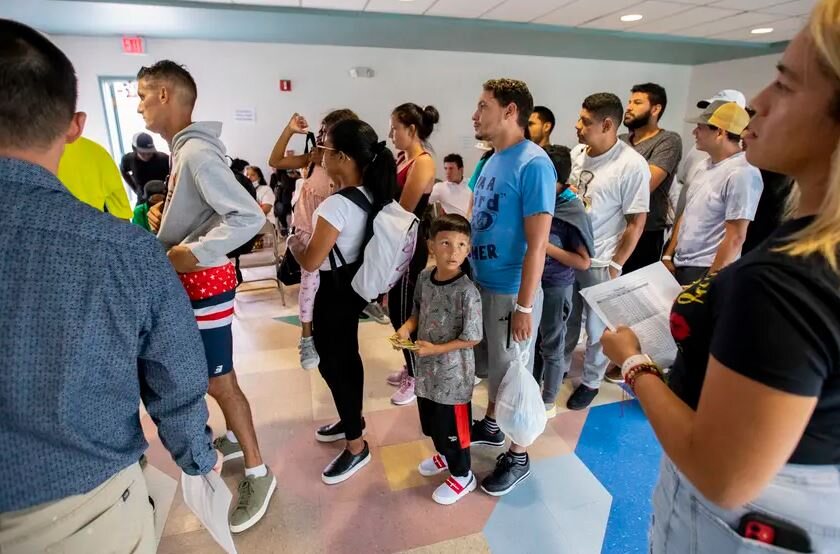As the number of individuals seeking refuge in New York City’s overcrowded homeless shelters approached a new high, Mayor Eric Adams made the decision to declare a state of emergency on Friday. This was in response to the arrival of thousands of migrants from Latin America.
He advocated for financing from the state and the federal government to assist pay for housing and services, and he asked the federal government to enable recently arrived asylum seekers to legally work and to limit the flow of migrants from the border into the United States heading northward. The population of the city’s main shelter system, which stood at 61,379 on Thursday, was on track to shatter the record of 61,415 established in 2019. He made these remarks as the record was about to be broken. At least nine further buses carrying migrants arrived on Friday.
Mr. Adams said that the number of migrants was on track to cause the population of the shelters to rise past 100,000, and that the inflow may cost the city an additional $1 billion in only the current fiscal year.
During one of his speeches, Mr. Adams said, “We need assistance, and we need it fast.”
The proclamation made by the mayor exempts emergency relief centres from the usual land-use and community-review procedures, which is often what causes delays in the creation of shelters. This makes it possible for the city to build shelters more rapidly.
Mr. Adams said that “New York City is doing our part,” and that at this point, others need to “stand up and join us.” In the past, mayors of New York City have proclaimed states of emergency in order to free up resources and temporarily suspend municipal laws. This was done, for example, during epidemics of monkeypox and Covid-19. The statement that Mr. Adams made on Friday, though, was one of the rare times that he has delivered a significant address in City Hall.
Since April, the city has seen an influx of around 17,000 migrants, the most of whom are attempting to escape the economic disaster in Venezuela. The Republican governor of Texas, Greg Abbott, who has been seeking to put pressure on the White House to increase border security, put thousands of people on buses and moved them out of the state. According to the authorities, there were 12,700 of the migrants staying in shelters as of Sunday.
However, the immigrants are not the only factor contributing to the rise in the number of people living without homes. Even if one excludes the 12,700 migrants now staying in shelters, the population of the city’s primary shelter system has increased by 6 percent since the middle of April. This is the largest increase in such a short period of time since 2015, when it occurred.
According to Joshua Goldfein, a staff lawyer at the Legal Aid Society, which brought the litigation that created New York’s unique right to shelter, the reasons are varied, but they can all be boiled down to one thing: the lack of affordable housing. Before migrants began to arrive, we were aware of a number of problems, but we haven’t been able to solve them all yet.
There is a shortage of homes at accessible price points, which is contributing to rising rents. After a pause due to the epidemic that lasted for two years, evictions were resumed. Because there are not enough people working in local enforcement offices, landlords may get away with unlawfully turning down potential renters who pay using government vouchers. Inmates are still being released straight into the city’s shelter system from the state’s correctional facilities. In addition, families who have been in shelters for victims of domestic abuse managed by other municipal agencies until they have reached the maximum number of allowed days are transferred to shelters administered by the Department of Homeless Services.
During the course of this year, Mr. Goldfein said that “a lot of those problems grew worse.”
People who check into shelters are staying there for longer periods of time. Since 2011, the average length of stay has more than doubled, reaching over 500 days now.
All of these issues have been given a greater sense of urgency as a direct result of the entrance of the migrants.
Over three years ago, Jerrica Ortiz, who was born and raised in the Bronx and is now 33 years old, was forced to cram her two boys and herself into a cramped room at a homeless shelter on the Upper West Side.
Since then, according to her, she has been unsuccessful in her efforts to obtain lodgings of a more permanent kind. She said that she was informed about a year ago that she qualified for a public housing apartment on the Lower East Side, but the move-in date has been pushed back because lead was discovered in her unit.
She has asked to be moved to larger shelter quarters while she waits; her older son, who sleeps in the bunk above her, is about to turn 12; however, she has been told that the new arrivals are taking up all the available space. While she waits, she has asked to move to larger shelter quarters; her older son sleeps in the bunk above her.
There are a significant number of individuals coming from countries other than Latin America who are seeking refuge in the nation’s homeless shelters. Hurricane Ian forced Leida Rivera to evacuate her apartment in Tampa, Florida, and she arrived at the women’s intake shelter in the Bronx on Wednesday after being forced out of her home by the flooding. She was given a bed in a room that had 15 other people in it.
